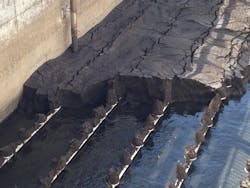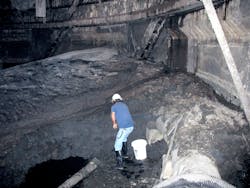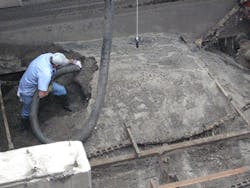The Importance of Grit Removal Performance Testing
Is your grit removal equipment performing to spec? If not, you could be putting your treatment process at risk. Grit that’s allowed to pass to other parts of the plant can accumulate in undesirable areas, causing abrasive wear, poor performance, and expensive maintenance. Here, Hydro International’s Pat Herrick discusses what you need to know about grit removal equipment performance and ensuring optimal capture efficiency.
Q: Why is it important to measure grit system performance?
PAT HERRICK: In terms of testing, it confirms that the system is operating per the specifications. That’s one of the top priorities. What we find with our technology in particular is that, because it is proprietary, the city will often require some form of validation that the system is working per spec because they want affirmation that they made the right decision to write a proprietary spec. If the system doesn’t work per spec, then all the features or benefits that we typically promote are not realized.
Q: What kinds of problems are likely to result if performance testing is not done?
PH: The biggest concern with a system that’s not performing per spec would be grit passing into the wastewater treatment process, causing abrasive wear, and taking up volume in process tanks (because the grit will settle and displace the liquid). [This is detrimental because] certain volumes are required for retention times in order for the biological treatment and sludge digestion processes to perform as designed.
Q: How does grit typically accumulate?
PH: If the plant has a primary clarifier, the primary will catch it, and then it goes to the digester. If a plant doesn’t have primary clarifiers, then usually the water goes straight from the headworks to the aeration basin, where the grit will accumulate in the aeration basin. This can lead to increased power draw from the blowers as the aeration diffusers get buried in grit. Obviously, these are all places where you wouldn’t want grit to accumulate.
From the digester perspective, if the plant has primaries, the grit goes to the digester. The grit is going to accumulate, displace volume, and reduce the performance of the digester in terms of its ability to destroy volatile solids and produce useful methane gas. Also, digesters are difficult and expensive to clean out later.
PH: Unfortunately, there are no industry standards for performance testing the capture efficiency of grit removal systems. There are a few generally followed procedures, but there’s no Water Environment Federation (WEF) or third-party validated protocol for performance testing. There is one commonality between most of the major equipment suppliers in that when you measure or do performance testing, it is generally agreed that seed sand should be used. Seed sand is basically commercial sand. When you buy it, you have a spec that outlines the particle size distribution and specific gravity of the material. It’s basically used as a marker.
Q: What are some typical challenges with performance testing of grit removal systems?
PH: One of the challenges is that grit can be a big portion of the solids load entering the plant during a wet weather event, but during normal daily operation there’s a relatively small quantity of grit entering the facility. So it’s very difficult to measure the capture efficiency of a major piece of process equipment like a grit removal system if there’s very little grit solids there to measure. By using seed sand, you’re taking a known quantity of grit and adding it typically right ahead of the grit removal system. This way, you’re sure that every pound is going right into the grit system.
Q: What is a typical strategy for testing the performance of a grit removal system?
PH: There are different methods for doing this, but the typical process is to measure the mass of grit coming into and out of the system. The differential is your capture efficiency. By adding, for example, 250 pounds of seed sand per million gallons coming into the plant, you amplify the mass coming in. It makes measurement much easier and far less prone to error in measurement and analysis of the solids.
Q: In the absence of performance testing standards, are there any third-party resources that are helpful?
PH: In terms of independent or third-party information, WEF has published an E-pub, Guidelines for Grit Sampling and Characterization. It’s geared toward sampling influent grit into the plant and it has some very good, useful information. It’s important to emphasize that this document only talks about sampling; it does not cover performance testing of the equipment itself.
Q: Why is it important to sample influent grit?
PH: Wastewater grit is not spherical and not all grit is silica sand. Grit has a settling velocity that typically differs from what its physical particle size would indicate. Factors such as size, shape and specific gravity influence the settling velocity of the grit particles. And to some extent, that’s why it’s important to do an influent grit characterization study.
Q: How does grit removal equipment currently get verified?
PH: As I mentioned earlier, the general recommendation for using seed sand is supported by the leading grit system manufacturers to make the testing more accurate. That said, most grit removal systems are not performance tested, partly because proper testing is expensive and time consuming. It’s not something that can be done effectively through simple grab samples. Typically, to complete one test it takes an entire day. It takes time to prepare for that, setting up sampling equipment and all the hardware that’s needed to pull the samples essentially on a continuous basis over several hours. That’s why a system doesn’t typically get tested.
Q: Why is it important to use an independent third party for performance testing?
PH: You want to ensure that the system is meeting the specifications, validating the decision that the city or plant staff has made to write a proprietary sole source spec. If a grit testing company that is affiliated with or owned by one of the equipment manufacturers is allowed to performance test the equipment, it’s essentially like having the supplier self-test the equipment, which really doesn’t serve much purpose in terms of getting an independent verification of the system.
Q: How does Hydro International, specifically, handle independent performance testing and verification?
PH: When we do performance testing, we defer to the contractor to hire a third-party validation testing company to eliminate any conflict of interest and ensure impartial testing and results. We also recommend outlining in the bid specifications what protocol is going to be used for the performance testing and who’s going to do the testing. If it’s not stipulated ahead of time, it gets left open to discussion later. Once the equipment has been supplied, it’s a little too late to be talking about it.
Q: Does performance testing need to be done periodically throughout the life cycle of the equipment or only once during initial installation?
PH: It’s almost always one and done. The presumption is that as long as the testing is done in a manner that reflects the proper operation of the equipment, the same results would be expected going forward, assuming that all the parameters are the same.
This is where the use of seed sand comes in. To some extent, it mimics a higher grit load, which helps to verify that the system can handle a higher load than what might be coming into the plant during a typical, non-eventful day. If it can function well under this simulated peak load, then it is expected to perform per spec during normal daily operation. WW
Hydro International provides advanced products, services and expertise to help municipal, industrial and construction customers to improve their water management processes, increase operational performance and reduce environmental impact. Learn more at www.hydro-int.com.


